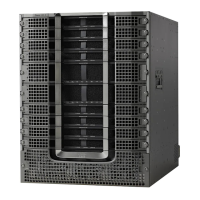•
cable qos pro max-ds-burst burst-size
•
show cable qos profile n [verbose]
DOCSIS 3.0 Downstream Peak Traffic Rate TLV Support for ERBA
The DOCSIS WFQ Scheduler allows each service flow to have one dedicated queue. When ERBA is enabled
for the service flow, the peak rate is implemented as the queue shape rate within the scheduler, while the
maximum sustained rate is set as the token bucket refill rate. When ERBA is turned off, the burst size and the
peak rate value are not used.
The maximum traffic burst parameter is used to control a service flow burst duration, to burst up to the channel
line rate or a configured peak rate, when it is within its maximum burst size allowance. On the Cisco cBR-8
Converged Broadband Router, the cable ds-max-burst command is used to control this behavior explicitly.
The peak-rate keyword is introduced to specify the peak rate an ERBA-enabled service flow can use. The
peak rate value is applied to a specific service flow created after the configuration of the cable ds-max-burst
command.
If the DOCSIS 3.0 TLV 25.27 is specified for a service flow, the peak rate value is set as the TLV value.
However, if ERBA is not turned on for a service flow, the peak rate value is ignored.
During modem registration or Dynamic Service Addition (DSA) operation, the service class name TLV 25.4
is sent to create the static or dynamic downstream service flow that matches the service class template. These
downstream service flows are created with a specific peak rate.
Some of the DOCSIS 1.x an DOCSIS 2.0 cable modems, which are not fully DOCSIS 1.x or DOCSIS 2.0
compliant, may fail to come online when the downstream peak rate TLV 25.27 is received from the CMTS
during registration. To overcome this failure, you can configure the cable service attribute withhold-TLVs
command to restrict sending of the peak traffic rate TLVs to DOCSIS1.x and DOCSIS 2.0 cable modems.
For more information on how to suppress peak rate TLVs, see Suppressing Upstream and Downstream Peak
Rate TLVs for pre DOCSIS 3.0 Cable Modems, on page 45.
The ERBA feature is not applicable for high priority service flows and multicast service flows.Note
Table below summarizes the ERBA support for the Cisco cBR-8 router.
Table 9: Enhanced Rate Bandwidth Allocation Support for the Cisco cBR-8 Router
Queue Shape RatePolicer Token
Bucket Size
Policer Exceed
Action
Policer Rate
Maximum Sustained
Traffic Rate
A value computed
internally by CMTS
(unused)
TransmitMaximum Sustained
Traffic Rate
(unused)
Traditional Service
Flow
Peak Traffic RateMaximum Traffic
Burst TLV
DropMaximum Sustained
Traffic Rate
ERBA-Enabled
Service Flow
In Cisco cBR-8 routers, the dual token bucket-based shaper is used to support ERBA on the Cisco cBR-8
CCAP line card (the ERBA feature is always enabled on the Cisco cBR-8 CCAP line card). The dual token
Cisco cBR Series Converged Broadband Routers Quality of Services Configuration Guide for Cisco IOS XE
Fuji 16.7.x
44
DOCSIS 1.1 for the Cisco CMTS Routers
DOCSIS 3.0 Downstream Peak Traffic Rate TLV Support for ERBA

